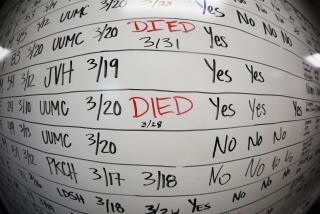MEDICINE : Taking Pain Out of Reading Medicare Mortality Reports
- Share via
Hospital officials have criticized the federal government’s annual reports on Medicare mortality at the nation’s hospitals as misleading. Many consumers who turn to the reports for guidance on where to seek medical care have found them inscrutable.
But next year, the U.S. Health Care Financing Administration (HCFA) plans significant improvements in the reports that should make them more useful and understandable to hospitals, physicians and consumers alike.
A key improvement is the decision to publish death rates for eight medical conditions and nine procedures that are common in the elderly. These include heart-bypass surgery, angioplasty, prostate surgery, gallbladder removal, hysterectomies, heart attacks and hip fractures.
The report will be “a much better publication for everybody,” said John Spiegel, deputy director of the HCFA’s Health Standards and Quality Bureau in Baltimore, which is responsible for the reports. It will be “more precise and easier to understand.”
The more specific statistics, while not a direct measure of the quality of care, should help patients discuss with physicians which hospital is best for common surgeries, and where to seek medical care for common problems.
Previously, the HCFA has lumped both illnesses and surgeries into broad “diagnostic categories” that meant little to consumers. The hospital’s overall mortality rate also was listed, and it will continue to be published. But overall mortality rates are difficult to interpret because the statistic includes patients with varying risks of dying.
The HCFA also will include information on mortality rates for three time periods after hospital admission--30, 90 and 180 days, as opposed to the single point of 30 days post admission used in previous years. According to the HCFA’s Spiegel, this change was made because different time periods are needed to evaluate the effectiveness of medical care for different conditions.
The improvements were announced earlier this month in a letter that Gail R. Wilensky, the administrator of the HCFA, sent to hospital administrators across the country. The hospitals were sent a copy of their own statistics. They have until Jan. 15 to review the statistics and submit explanations to the HCFA. These explanations will be published as part of the report.
In a related development, the United Network for Organ Sharing, the Richmond-based organization that keeps organ transplant statistics, is soon expected to release for the first time survival data for the nation’s transplant centers.
Mortality rates are only one of many measures of hospital performance. But the review of deaths to determine which ones might have been preventable can often lead to improvements in the quality of care.
The HCFA runs Medicare, the federal health insurance program for the elderly and disabled. Its annual Medicare mortality reports, which have been published since 1987, have received considerable public attention.
The most recent report, released last December, was based on a computerized analysis of about 10.5-million Medicare admissions at nearly 6,000 acute-care hospitals during 1988.
The mortality rate statistics reflect the percentage of a hospital’s Medicare patients who die within a certain number of days of being admitted, whether as patients or after discharge. This actual mortality rate is compared to a hospital’s predicted mortality rate, which will be published. The predicted mortality rate estimates the relative risk of dying for patients based on such characteristics as age, sex, other diseases and previous hospitalizations.
The next report, expected to be published early next year, will cover Medicare patients discharged from the nation’s acute care hospitals in the fiscal year between October, 1988, and September, 1989. For comparison, statistics will be included for patients discharged from the same hospitals in the fiscal years 1987 and 1988.






